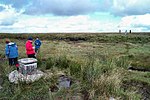Hangingstone Hill

Hangingstone Hill is a hill in North Dartmoor in the southwest English county of Devon. At 603 metres high, it is the joint third highest peak in Devon and Dartmoor, together with Cut Hill, which lies around 4 kilometres to the southwest. The hill lies within the military training area on Dartmoor and is not accessible to the public except at certain times. There is a military road to the summit, which is marked by an Army observation post and flagpole. On clear days, the views are "superb", extending to Exmoor, the Quantocks, the River Teign estuary, and many of Dartmoor's peaks. The name of the hill is derived from a logan rock on the northwest hillside which no longer rocks, however. It was formerly known as Newtake Hill. Hangingstone is one of Dartmoor's thirteen Deweys and the tenth highest in England. About 600 metres almost due south is the summit of Whitehorse Hill which is a subpeak or twin peak of Hangingstone Hill. It has a drop of less than 10m.
Excerpt from the Wikipedia article Hangingstone Hill (License: CC BY-SA 3.0, Authors, Images).Hangingstone Hill
Steeperton Tor Road, West Devon Dartmoor Forest
Geographical coordinates (GPS) Address Website Nearby Places Show on map
Geographical coordinates (GPS)
| Latitude | Longitude |
|---|---|
| N 50.6586 ° | E -3.9566 ° |
Address
Range Warning Flagpole
Steeperton Tor Road
EX20 1QZ West Devon, Dartmoor Forest
England, United Kingdom
Open on Google Maps










